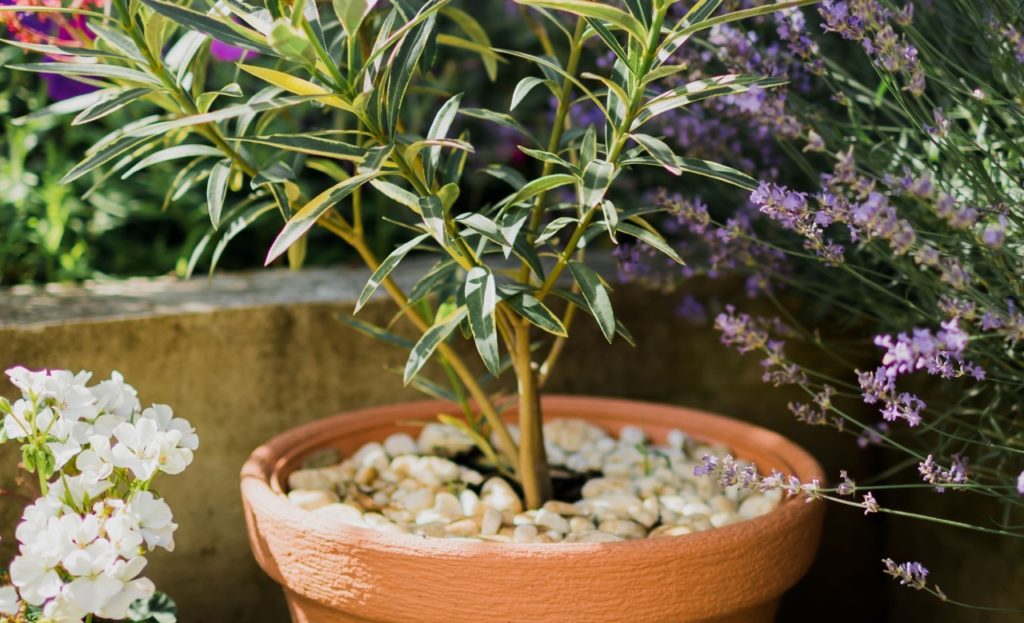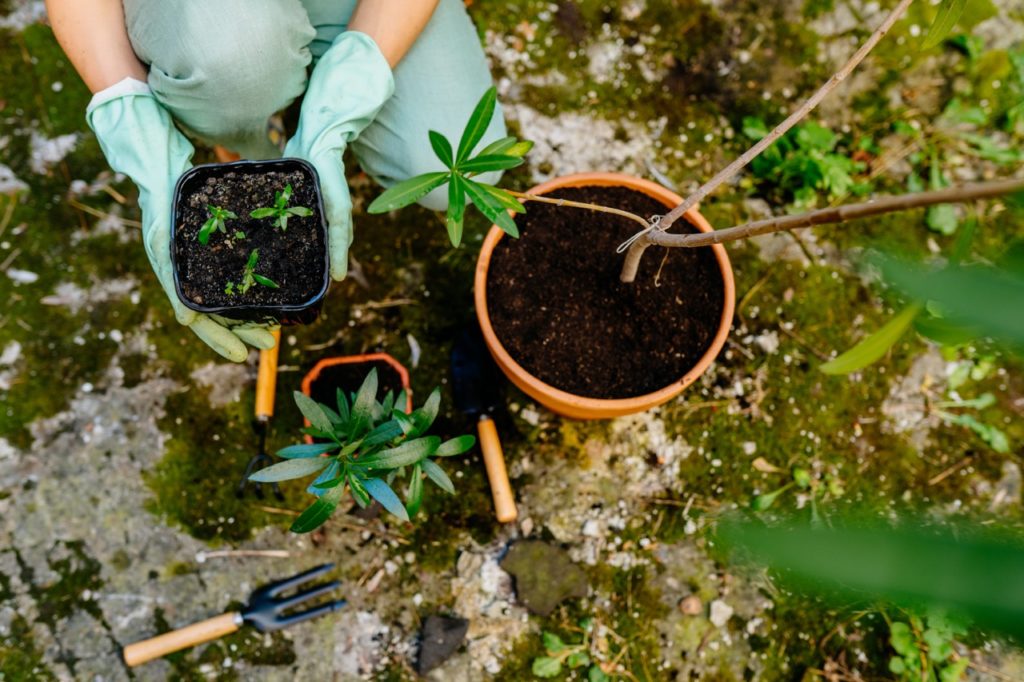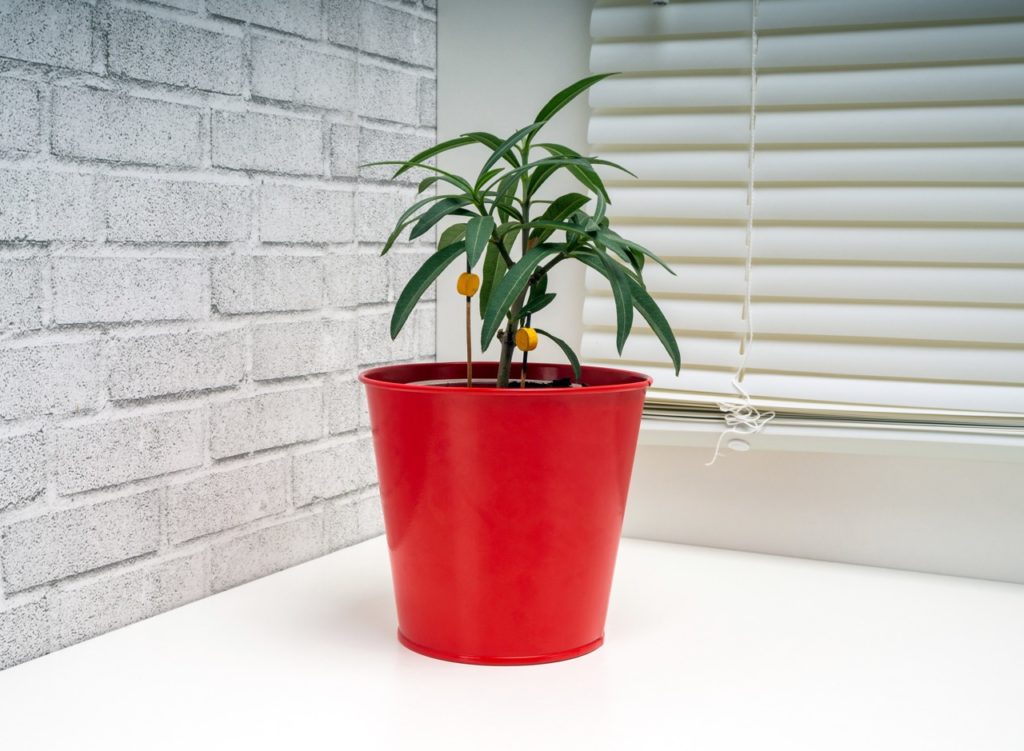Grow Oleander Varieties In Decorative Containers – They Look Great Outside The Home

SHRUBS > OLEANDER > CONTAINERS
Reviewed By COLIN SKELLY

Colin is a Horticulturist and Horticultural Consultant with experience in a range of practical and managerial roles across heritage, commercial and public horticulture. He holds the Royal Horticultural Society’s Master of Horticulture award and has a particular interest in horticultural ecology and naturalistic planting for habitat and climate resilience.
IN THIS GUIDE
OLEANDER GUIDES
Container Growing
Cuttings Propagation
Overwintering
Pruning
Oleanders are big, well-branched plants that impart a Mediterranean atmosphere to the garden or to the porch – or even by your front door.
These sun-loving evergreens have very pretty foliage that is comprised of small, lanceolate leaves in various beautiful shades of green, and some varieties even have variegated foliage.
All varieties produce lots of little salver-shaped, sometimes cup-shaped, flowers throughout the summer and into autumn.
Colours include white, pink and resin tones ranging from delicate pastels to striking vibrant reds.
Oleanders are frost-tender, warm-weather plants that are fuss-free and remarkably easy to grow if you simply protect them from the cold.
Are Oleander Suited To Containers?
Not only can you grow Oleander in pots, but oleander varieties in decorative containers are also often placed near the front door of homes.

Also, these big evergreens can stay in their big pots outdoors year-round.
It’s actually better to grow your oleanders in pots in the UK, as these frost-tender shrubs have a hardiness rating of H3, meaning they cannot survive through the winter in most parts of the UK if planted in open ground.
Which Containers Are Best?
It is most important for the container to have drainage holes as the soil must drain very well.
Other than that, we suggest a sturdy pot in the form of a truncated cone or truncated pyramid.
Feel free to use a decorative container made of synthetic material.
As a general rule, the height of the container should be about half the height of the above-soil height of the plant.
Oleanders are quite big with fully-grown plants averaging 2m in height and 1.5m in spread.

So, no matter which variety you grow, at some point you will need a large container.
Since most UK gardeners will almost surely be moving the plant indoors sometime in the autumn and shifting it back outdoors in spring, you may wish to keep in mind the size and weight of a container-bound oleander variety.
“I recommend trying moving your pot size around before planting it, as with any large shrub,” shares Colin Skelly, a Horticultural Consultant.
“This is particularly true for Oleander because it will need to be moved in and out every winter.
“A sack trolley is an indispensable piece of equipment but make sure there is room to manoeuvre and support for going up or down slopes or stairs.”
Which Growing Medium Is Best?
Oleander is one of those unusual shrubs that will struggle if grown in rich, fertile soil.
Put it in poor soil and it is relatively content.

For best results, take a mixed loam and amend with a very conservative quantity (around 25%) of organic compost.
Soil should be very well-draining, so incorporate grit or perlite, especially if the sand content is low.
The optimal soil pH for oleanders is slightly alkaline but they will cope in neutral soil.
Potting Up Oleander
Oleander’s growth rate can vary significantly depending on your location in the UK, so select your container size accordingly.
The warmer and more humid the weather, the faster it will grow.
In most parts of the UK you can pot up oleander to the next pot size up.

However, in the balmiest regions of the country, especially if you have noticed fast growth, you may as well pot on to a pot 2 sizes up.
How Many Can You Plant Per Pot?
One, full-stop.
Potted Oleander Care
Oleanders need regular watering.
Soil should be kept moist but not soaked, especially during summer and hot weather and especially for young plants.
In such conditions, you may well need to water even every day.
Mature, established plants, even in containers, can get by if you skip a watering or two.
Outdoors, keep the pot in a south-facing, sheltered location in full sun.

In the less cold regions of the British Isles, during the summer you can certainly keep the container in any old place outdoors.
However, you may keep your potted oleander plants outdoors only when the temperature is 10°C or higher.
Anything lower and they need to be brought indoors.
When inside, keep the container by a (closed) window where it will get full sun through the pane.
The window should have to have an eastern-to-southern aspect and normal room temperature will suit these plants very well.

In the middle of spring when the weather has warmed up, you may shift a mature, established oleander directly outdoors, but a young, growing plant should undergo a process of hardening over at least 4-5 days before being left outdoors.
Oleanders do not need fertilising.
However, if you wish, in mid-spring just after you observe fresh growth you can work in slow-release granules into the soil.
Alternatively, apply a liquid fertiliser once in mid-spring and once in mid-summer.

